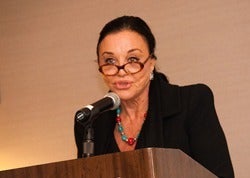November 1, 2012 — It’s not enough to refrain from harm. We must take positive action.
This is the core message of The Cost of Inaction: Case Studies from Rwanda and Angola, a new book published by the François-Xavier Bagnoud Center for Health and Human Rights that introduces a method to determine the true costs of failing to help the world’s poorest children.
“This is a far-reaching book with a deceptively modest title,” Nobel Prize-winning economist Amartya Sen writes in the foreword. “Doing nothing seems far from innocent — indeed depending on our understanding of human obligation to others, it can be full of potential folly, and perhaps even the basis of a sense of actual guilt …”
Sen was one of two Nobel Prize laureates to speak at an October 23, 2012, program at the Charles Hotel in Cambridge celebrating the book’s publication. Along with Sen, who is Thomas W. Lamont University Professor at Harvard, the program’s speakers included Harvard’s Eric S. Maskin, Adams University Professor and a 2007 Nobel laureate; the book’s lead author, Sudhir Anand, Professor of Economics at St. Catherine’s College, Oxford University; and Countess Albina du Boisrouvray, the founder of FXB International, an organization that focuses on AIDS orphans and vulnerable children. Her FXB Foundation also established Harvard School of Public Health’s FXB Center.
As described in the book, the cost of inaction — or COI — is not zero but rather the ultimate cost of failing to do some particular thing. For example, the failure to provide preventive health includes not only the resulting medical costs but also the costs that ensue when a sick child is unable to go to school and obtain the education necessary to become a law-abiding and functioning member of society.
What distinguishes COI from a traditional cost-benefit analysis is that it enumerates and quantifies the full social and economic costs of failure to perform a specific action. Developed at Harvard’s FXB Center, COI is central to the Center’s approach to the health, well-being, and rights of children. The book grew out of the Center’s ongoing COI project, which is directed by Professors Sen and Anand and supported by an interdisciplinary team of researchers.
While the COI approach is subject to wide-ranging application, it has special relevance for the treatment of children, where the costs of failing to act will be felt “over a long period of time — their entire lifespan” and where the resulting damage is likely to be irreversible, notes Anand. (On a happier note, the benefits of investing in children — in nutrition, health, and education — will have a similarly outsized impact.)
The driving force behind COI is Boisrouvray, who established FXB International in honor of her son and only child, a helicopter pilot who died at 24 in a 1986 mission to Mali. Over the past 23 years, FXB International has worked at the grassroots level in more than 80 countries to develop sustainable and community-based solutions to poverty and AIDS.
After more than two decades, Boisrouvray remains an impassioned advocate of those she calls “the discarded generation,” and she stresses that the larger world ignores them at its peril.
“There are more than a billion of these children around the world,” she said in an interview. “They are living in extreme poverty. They live by codes of conduct completely divorced from ours, and the older they get, the harder it will be to reintegrate them, even at great cost. Each day, they drift further and further. A huge percentage of the world’s adults are going to be almost a different species. This is terrible for society and for the economy — for everything officials are supposed to be worried about — as well as terrible for the kids.”
In Boisrouvray’s eyes, this is nothing short of a global emergency, and her hope is that the rigorous COI framework with its Harvard pedigree will arm children’s advocates with tools to generate the data needed to galvanize the world’s decision makers. “This is a way to pressure governments,” she says. “The ethical and moral arguments have not been enough. We need really good data so people won’t be able to look away.”
Photo by Aubrey LaMedica
